| Alemani | |
|---|---|
 | |
| Alternative name(s) | Alamani, [1] Alameni, Allemani |
| Earliest mention | 1455 |
| Families | 4 names Alamenus, Alemani, Limanowski, Rudelewicz |
Alemani is a Polish nobility coat of arms originated from Italy.
| Alemani | |
|---|---|
 | |
| Alternative name(s) | Alamani, [1] Alameni, Allemani |
| Earliest mention | 1455 |
| Families | 4 names Alamenus, Alemani, Limanowski, Rudelewicz |
Alemani is a Polish nobility coat of arms originated from Italy.
The Alemani coat of arms was a family crest brought to Poland from Italy by Dominik Allemani who received an Indygenat (recognition of foreign status as a noble) from King of Poland Zygmunt August on 19 April 1566. Dominik Allemani became a stolnik of Lublin and starost of Nowe Miasto [2]
<Azure, two bends or impaling argent three pellets two and one. Crest: issuant from a crest coronet or a demi-maiden habited azure, crined or, wearing a wreath vert and holding in her dexter hand a wreath of the same, her sinister hand resting on her hip. Mantled dexter or and azure, sinister sable and argent.>
| | This section is empty. You can help by adding to it. (July 2010) |
Notable bearers of this Coat of Arms include:

Nałęcz is a Polish coat of arms. It was used by associated szlachta families in the Kingdom of Poland and the Polish–Lithuanian Commonwealth (1569–1795).
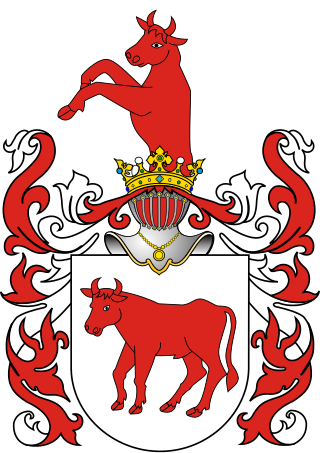
Ciołek is a Polish coat of arms, one of the oldest in medieval Poland. It was used by many szlachta (noble) families under the late Piast dynasty, under the Polish–Lithuanian Commonwealth, during the Partitions of Poland, and in the 20th century. The variant names "Siolek" and "Cialek" arose from miscommunication among early-20th-century Polish immigrants to the United States.
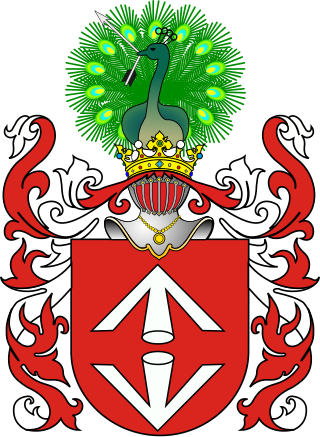
Bogoria is a Polish coat of arms. It was used by several szlachta families in medieval Poland and later under the Polish–Lithuanian Commonwealth, branches of the original medieval Bogoriowie family as well as families connected with the Clan by adoption.
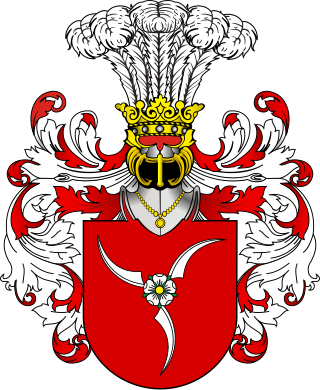
Rola is a Polish coat of arms. It was used by several szlachta families in the times of the Kingdom of Poland and Polish–Lithuanian Commonwealth.

Topór is a Polish coat of arms. It was used by several szlachta (noble) families in medieval Poland and under the Polish–Lithuanian Commonwealth.

Ogończyk is a Polish coat of arms. It was used by several szlachta families in the times of the Kingdom of Poland and the Polish–Lithuanian Commonwealth.

Łodzia is a Polish coat of arms. It was used by many noble families of the Kingdom of Poland and the Polish–Lithuanian Commonwealth. A variant serves as the coat of arms of the city of Łódź. It's a classic example of the so-called canting arms well known in European heraldry as it was borne by the medieval lords de Łodzia and their clan. Hence the boat in the shield, clearly alluding to the estate's name literally meaning Boat. Coats of Arms in the Polish Lithuanian Commonwealth were a symbol of a heraldic clan.

Polish heraldry is the study of the coats of arms that have historically been used in Poland and the Polish–Lithuanian Commonwealth. It treats of specifically Polish heraldic traits and of the Polish heraldic system, contrasted with heraldic systems used elsewhere, notably in Western Europe. Due to the distinctive ways in which feudal societies evolved. Poland's heraldic traditions differ substantially from those of the modern-day German lands and France.
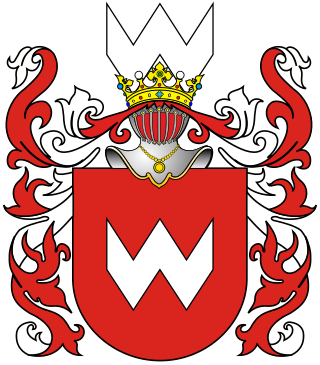
Abdank is a Polish coat of arms. It was used by several szlachta families in the times of the Kingdom of Poland and the Polish–Lithuanian Commonwealth.

Alabanda is a Polish nobility coat of arms, used by several szlachta families in the times of the Kingdom of Poland.
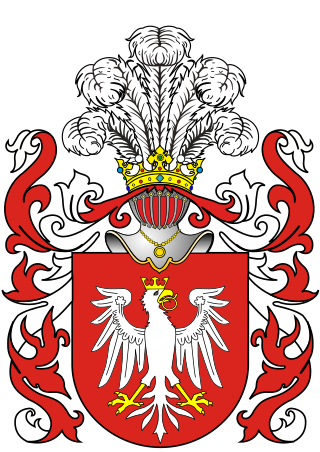
Amadej is a Polish coat of arms. It was used by several szlachta families in the times of the Kingdom of Poland and the Polish–Lithuanian Commonwealth.

Bojcza is a Polish coat of arms. It was used by several szlachta families.

Wieniawa is a Polish coat of arms. It was used by several noble, in Polish language szlachta families in the times of medieval Poland and the Polish–Lithuanian Commonwealth.

Hozyusz is a Polish coat of arms. It was used by several szlachta families.

Drużyna is a Polish coat of arms. It was used by several szlachta families in the times of the Kingdom of Poland and the Polish–Lithuanian Commonwealth.

Gozdawa is a Polish nobility Coat of Arms. It was used by several szlachta families in the times of the Kingdom of Poland and the Polish–Lithuanian Commonwealth.

Jeż is a Polish coat of arms.

Achinger is a Polish coat of arms. It was used by several szlachta families in the times of the Kingdom of Poland and the Polish–Lithuanian Commonwealth.
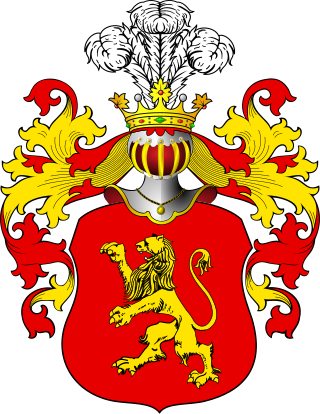
Lew II - Polish coat of arms, used by several genera. Two of them were families from the region of Kaszuby. Coat of arms "Lew II" is a variant of the coat of arms "Leo".
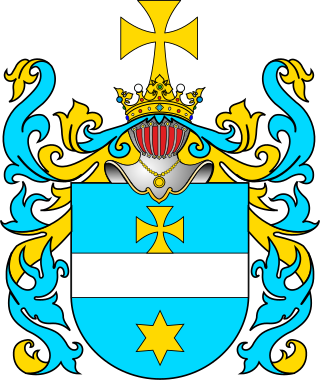
Krucina is a Polish coat of arms. It was used by the Korniakt family (szlachta) in the Polish–Lithuanian Commonwealth.